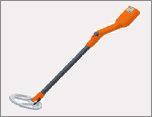What is the best way to locate plastic, PE, HDPE, PVC, or non metallic pipes?
There are a couple of different ways to locate non metallic pipes. One option is to use the same electromagnetic signal generator that is used to locate metallic pipes. Of course the pipe being plastic the signal will not travel along the pipe (non conductive), Instead you insert a fibreglass reel, (4mm or 6mm in diameter) which has a copper conductive core, into the plastic pipe and the electromagnetic signal travels along the copper core; you then detect the signal with the pipe locator at the surface.
Another way of tracing a plastic pipe is to use acoustics. There are 2 ways of making a noise on a pipe, both use the the battery powered Combiphon unit. Option 1 is to strap the Knocker around the pipe, it gently "taps" on the pipe; using a ground microphone you listen above the pipe for the loudest point.
The second method is more often used for mains water distribution pipes. Using a stand pipe on a suitable hydrant a Stopper is inserted into the outlet of the stand pipe. Water flows through the Stopper which is alternatively restricted and opened in flow by a piston. There is a resulting "heart beat" noise for which you listen on the surface with a ground microphone for the loudest position.
I am trying to locate a metallic water pipe, which pipe location tool would be best for me?
Answer: The UtiliTrac is a metallic pipe locator-tracer; it works on the principal of detecting either an applied electro magnetic field (attached by a signal generator, sometimes called a genny), or by detecting re-radiated radio signals.
I need to trace the route of a plastic pipe. I have been told that a CAT and Genny cannot do this; do you have a tool that locates plastic pipes?
Answer: You are correct. You cannot apply an electromagnetic signal from a signal generator (genny) onto a plastic pipe; it cannot conduct the electromagnetic field. However, you can insert a fibreglass reel with a conductive copper centre into the plastic pipe and trace the electromagnetic field carried on the copper coil from the genny. The UtiliTrac R130 combined with a Tracing Reel is used for this purpose. Another option to locate plastic water pipes is the CombiPhon. This uses noise as the location method. You either attach a Knocker onto the pipe which taps on the pipe and using a sensitive ground microphone such as the Aquaphon A100 you listen for the resulting noise. Alternatively, you can use a Stopper attached to a hydrant to oscillate the water in the pipe and listen for the resultant noise on the surface above the pipe. Where it is loudest is the pipe's location.
I want to locate the end point of a pipe or a blockage in a pipe; what do you have to assist me?
Answer: A Sonde (sometimes called a mouse) is a small signal generator. It is attached to the end of a fibreglass reel. The reel is inserted into the pipe and the sonde’s electromagnetic signal is detected by the UtiliTrac
I am using a basic CAT and Genny, a Cable Avoidance Tool, and am having difficulty tracing the route of a pipe; do you have anything that can assist me?
Answer: A CAT and Genny is a useful tool if you are simply trying to avoid hitting utility services when excavating (its name derives from its initials CAT - Cable Avoidance Tool). For safety reasons you do not want to hit services or power lines when excavating on site and a simple Cable Avoidance Tool is often adequate for that purpose but in order to accurately trace the route of a pipe or cable you sometimes require a more sophisticated pipe location tool. The UtiliTrac offers many advantages in locating water pipes, gas pipes, power cables and other utility services whilst still being easy to use.
I am having difficulty locating an electrical cable over a long distance. Would your cable locator help me?
Answer: Yes. The UtiliTrac has a powerful 10W transmitter and various frequency outputs. This will assist you in locating a cable over a long distance. Many Cable Avoidance Tools, CAT and Gennys, have only a 1W, or even less, signal generator and the signal cannot travel very far.
I need to trace a metallic pipe and there are other pipes alongside the one I wish to trace. The signal from my Genny is jumping onto the other pipes. What can I do?
Answer: The electromagnetic signal used to trace metallic pipes and cables will jump onto other adjacent utility services. The UtiliTrac pipe locator has a number of features to help stop this happening. It has: variable signal generator power outputs, a wide range of output frequencies, it indicates the depth to the pipe or other utility service being detected as well as showing the signal strength. All these features assist in more precise location.










